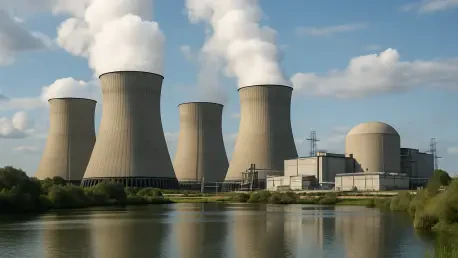Setting the Stage for a Nuclear Market Shift
In a landscape where clean energy demands are surging, driven by data center expansions and ambitious decarbonization targets, the U.S. nuclear energy sector stands at a critical crossroads. The Department of Energy (DOE) has rolled out a groundbreaking reactor pilot program, initiated under an executive order signed earlier this year, aiming to fast-track advanced nuclear reactor development. This initiative isn’t merely a technical experiment; it represents a potential pivot point for market dynamics, promising to reshape investment flows, energy supply chains, and global competitive positioning. With a tight deadline to achieve criticality for at least three test reactors by mid-2026, the stakes are high. This analysis dives into the market trends, data, and projections surrounding this bold move, exploring whether it can revitalize a dormant industry or risk becoming a costly misstep.
Market Trends and Data Driving Nuclear Energy’s Potential
Historical Context and Current Market Gaps
The U.S. nuclear energy market has been in a state of stagnation for decades, with high-profile safety concerns and prohibitive costs stifling growth. Once a leader in nuclear power generation, the nation now operates fewer new projects compared to global players like China and Russia, who have already deployed advanced reactors. Domestic energy demand, however, is escalating rapidly—projections estimate a 15% increase in electricity needs by 2030, largely fueled by tech-driven sectors. This gap between supply and demand creates a ripe opportunity for nuclear to reclaim market share, especially as renewable sources like wind and solar struggle with intermittency issues. The DOE’s pilot program emerges as a strategic response to these pressures, aiming to bridge the divide with innovative technology.
Pilot Program Specifics and Market Signals
Under the DOE initiative, 11 projects from 10 companies have been greenlit as of mid-2025, with a unique structure bypassing traditional Nuclear Regulatory Commission (NRC) oversight in favor of direct DOE authorization. This move slashes bureaucratic timelines, targeting operational reactors within a year—a stark contrast to the industry’s typical decade-long cycles. Market analysts view this as a signal of intent to attract private capital, with self-financing requirements for companies potentially drawing in equity firms and utilities. Early data suggests investor interest is picking up, with venture capital in nuclear tech startups rising by 20% since the program’s announcement. Yet, the absence of NRC involvement raises questions about perceived safety, a factor that could deter risk-averse stakeholders.
Global Competition and Domestic Implications
On the global stage, the U.S. faces stiff competition in the nuclear market, with countries like Canada and France advancing small modular reactors (SMRs) at a faster pace. The DOE’s aggressive timeline could position the U.S. as a frontrunner if successful, potentially opening export markets for American nuclear technology by 2027. Domestically, the program aligns with broader energy strategies, including restarts of shuttered light-water reactor (LWR) sites to meet immediate needs. However, market observers note that any misstep in LWR operations or fuel management could ripple through investor confidence, impacting the pilot’s funding landscape. Balancing these dual tracks will be crucial for maintaining market stability and growth momentum.
Future Projections and Market Analysis
Short-Term Outcomes and Investment Triggers
Looking ahead to the mid-2026 deadline, the success of even one pilot reactor achieving criticality could act as a catalyst for market transformation. Such a milestone would validate advanced reactor designs, providing a tangible benchmark for scalability and commercial viability. Projections indicate that a successful demonstration could unlock upwards of $5 billion in private investment over the following two years, as infrastructure funds and utilities gain confidence. Conversely, technical failures or safety lapses could stall momentum, with market sentiment potentially shifting toward alternative clean energy solutions. The next 12 months will serve as a litmus test for gauging investor appetite and regulatory adaptability.
Long-Term Market Shifts and Energy Landscape
Beyond the immediate horizon, the pilot program holds the potential to redefine the U.S. energy market by the end of the decade. If modular reactors prove scalable, they could address chronic power shortages, particularly for high-demand sectors like data centers, which are expected to double their energy consumption by 2030. Market forecasts suggest nuclear could capture a 10% larger share of the clean energy mix if costs are driven down through streamlined processes. Additionally, geopolitical benefits loom large—success could enable the U.S. to export nuclear tech, countering rivals and strengthening energy security alliances. However, persistent public skepticism or regulatory hiccups could limit this growth trajectory, keeping nuclear as a niche player.
Risk Factors and Market Volatility
While optimism surrounds the program’s potential, significant risks loom over market projections. Public perception remains a volatile factor; any hint of compromised safety due to expedited timelines could trigger backlash, derailing projects through legal or social opposition. Financial risks also persist, as the self-financing model places heavy burdens on companies, potentially leading to project delays if funding dries up. Market analysts warn that broader nuclear sector challenges, such as spent fuel management or LWR restart complications, could cast a shadow over the pilot’s credibility. Mitigating these risks will require transparent communication and robust oversight to stabilize market confidence.
Reflecting on Market Insights and Strategic Pathways
Looking back, the analysis of the DOE’s reactor pilot program revealed a complex interplay of opportunity and risk within the U.S. nuclear energy market. The initiative stood out as a bold attempt to address critical energy gaps and reposition the nation as a global leader, yet it grappled with challenges of safety perception and investment uncertainty. For stakeholders, the path forward demanded a focus on building public trust through clear, consistent messaging about safety protocols. Policymakers and industry leaders needed to prioritize robust DOE oversight while fostering partnerships with private investors to share financial risks. Monitoring global nuclear trends also became essential to adapt strategies and maintain competitiveness. These steps, if executed thoughtfully, offered a foundation to transform early pilot successes into sustained market growth, shaping a resilient future for nuclear energy.









